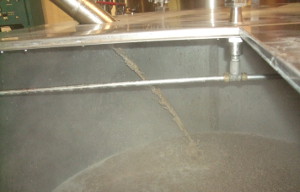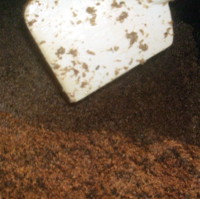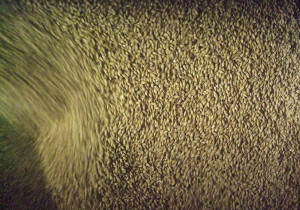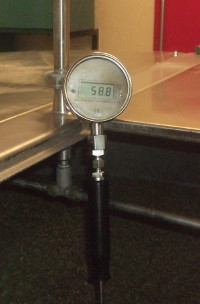At the end of October 2013 I spent a very pleasant and interesting day at S A Brain in Cardiff, helping create my first ever collaboration beer, Brabo, on the Brains Craft Brewery. The resulting beer didn’t win the Brains competition for the year, but it’s received some very positive feedback.
This piece, which I’m publishing in several parts, documents the experience in detail — you might find it interesting as an insight into the process of brewing, Brains brewery and the craft brewery project, and the origins of the spéciale belge style of Belgian pale ale. This section on the process of mashing our beer was preceded by sections on developing the recipe, Brains brewery and its ‘craft’ offshoot and an introduction; a final section will cover the boil and getting the beer to fermentation.
You don’t need to have direct experience of brewing to understand that it’s a complicated and difficult process. Makers of wine, cider and perry no doubt face their own challenges, but at a basic level all they have to do is extract the sugar rich fruit juice, and allow it to ferment with yeasts that are conveniently already present on the skin of the fruit.
Brewers, in contrast, start from several stages back. Their chosen raw material, grain, is also rich in carbohydrate, but in the form of insoluble and unfermentable starch. Facilitating the chemical reactions that will convert this efficiently into a tasty meal for the yeast, while avoiding too many unwanted byproducts that would taint the end result, accounts for much of the challenge.
These days, this process has usually already started in the maltings, when the early stages of germination create the conditions for the release of sugars that, if nature took its course, would fuel the growing plant. Brewers have to complete this process, deploying hot water, or liquor as it’s known in the trade, to prompt the release of enzymes.

Grist mixed with hot liquor fills the mash tun as the brewing of Brabo gets underway.
These naturally occurring chemical helpers then break the links between the chains of molecules in the starch to create something water can dissolve and yeast can metabolise. It’s not surprising that many brewers have a scientific background, even if their hearts and palates are firmly in the arts.
Working through a brew day highlights the immense patience and impeccable timing needed to achieve this. Good brewing involves bouts of physical activity and long periods of waiting, for precisely the right time when precisely the right amount of water at precisely the right temperature acheives ‘saccharification’, as the breakdown into sugar is known.
Then there’s the lengthy boil necessary to ensure the appropriate levels of hop bitterness make it into the finished product. It’s also not surprising that brewers, present company included, are generally sociable types, filling the inevitable longueurs with easy conversation.

The thickness of the mash is evident from the way it sticks to this spade.
When I arrive at the brewery at my luxuriously late hour, one of head brewer Bill Dobson’s colleagues has already mixed and milled the ‘grist’ – the brewer’s term for the dry ingredients – and left it ready in the grist case above the mash tun. Bill himself has warmed the tun by flushing it with hot water, like a giant teapot. I’m reminded that in certain parts of England, making tea is known as ‘brewing’ or ‘mashing’.
Mashing, that all important soaking of the grist in hot liquor, is the first major stage of the brewing process, and I’ve seen it taking place before in other breweries, but I’ve never been there for ‘mashing in’, when grist and liquor first fill the tun.
Brains uses ‘town’s liquor’ drawn from the regular water supply, although there is a disused well on site. This is easily improved for brewing purposes by adding small amounts of minerals, so 800g of calcium chloride and 1.3kg of calcium sulphate have been sprinkled into the grist case too. The liquor is heated at a central point and piped around the plant along with cold liquor so both can be mixed at the vessel to achieve the right temperature.
The ‘strike temperature’ – the temperature of the liquor as it strikes the grist – is the first of a number of crucial parameters: in this case, it’s 73°C. Bill first runs 170l of liquor into the tun, carefully checking the flow rate to ensure it’s at the optimum 55l per minute.
Once the plates at the bottom of the tun are safely covered with water, the grist case is opened. Both grist and liquor then mix in the pipe above to create a notably thick, porridge-like, sweet smelling slurry.
Even this relatively simple process takes patience and care: the mash must flow at the right rate and with the right consistency, so it flows evenly into the vessel without piling up into a heap. Occasionally Bill assists the flow with the lo-tech expediency of a few blows from a rubber mallet
Brabo will undergo a simple ‘infusion mash’ at a single temperature, traditional in British brewing and in some styles of Belgian brewing, including for the creation of old fashioned ales like ours. The mash tun itself isn’t heated, so depends on the heat of the added liquor and good insulation – the outside of the vessel stays remarkably cool.
It takes 20 minutes to fill the mash tun, and then we leave the mixture to stand for an hour at a temperature around 66°C. It’s a great opportunity for breakfast in the staff kitchen: toast with some of Bill’s own delicious homemade jam. Although he’s not a home brewer, he clearly can’t stop coaxing interesting chemical reactions from sugary liquids heated in large metal containers even in his spare time.
Back in the brewhouse, I realise that fluid dynamics plays a role as well as chemistry. Like most people with more than a passing interest in brewing I could tell you that mashing is followed by sparging and then boiling, but what I never thought about until now is quite how much is involved in getting the sweet liquid from the mash tun – the unhopped wort,– into position for the boil.
Some larger brewhouses dedicate an entire specialised full sized vessel, the lauter tun, to this delicate process, but in typical small British breweries, as here, the mash tun and a few other bits and pieces do the trick.
Sparging involves spraying more hot water gently on top of the wort, and the mash tun is fitted with a rotating sprinkler arm for this purpose. The procedure rinses away as much fermentable material as possible from the grains and makes up the wort to the correct concentration of sugar, but what I’ve only just realised is that it also plays a role in moving the wort from one stage to the next.
Think about it for a minute. You have 450kg of grains suspended in 1,250l of hot liquid in a big metal container, and you now have to get that liquid out cleanly so that it can be boiled. Simple – you put a hole at the bottom of the container with a mesh filter so the liquid simply flows through, and then pump it to wherever you want it next.
The problem is those grains – currently they’re easy to deal with as they’re floating, but as the liquid drains away they’ll start to settle under gravity, and if it happens too fast they’ll form a practically impermeable plug that traps the liquid nearest the top in the tun.
The answer is to regulate the flow, and the sparging works to do this alongside the ‘underback’, the recycled keg mentioned earlier, which helps ensure a steady flow from below. The underback is fitted with an automatic detector which triggers a pump when the contents reaches a certain height, and the first clear wort begins to run into the next vessel, the copper.
Sparge liquor is usually hotter than the mash but not too hot that unwanted compounds like proteins and polyphenols start to seep out. The water currently spraying from the sprinkler at 15l a minute is heated to a steady 77°C.
It’s time to take our first sample, admire its rich amber colour and and sneak a quick taste. It’s not the first time I’ve tasted unhopped wort but there’s something even more enjoyable about trying some for a beer I have a hand in creating.
I’ve got a sweet tooth, and it’s luxuriously sweet, but with that crispy, slightly drying cereal character coming through from the coloured malt. Beer judges and reviewers often mark finished beers down for a ‘worty’ note, usually a sign that the beer hasn’t fermented out properly and residual sugars are too apparent, though I secretly enjoy a touch of lingering liquidised breakfast cereal.
But there are more accurate ways than our taste buds of judging whether those enzymes are behaving as expected. We take our sample to a bench and sink round the corner, where Bill pours it into a double-walled copper flask, and runs cold water between inner and outer walls.
When the wort is cool enough, he pops in a hydrometer, or more precisely, a saccharometer: a glass instrument with a long, thin tube emerging from a bulbous weighted float. Sugar solution is denser than water, so the sweeter the liquid, the higher the tube will float, enabling us to read off the ‘specific gravity’ (also known as ‘relative density’) from a calibrated scale engraved into it.
It might sound trivial, but seeing this simple instrument bobbing about in my wort gives me a resonant moment. The saccharometer was one of the earliest scientific instruments adopted by brewers during the early expansion of industrial brewing in the 18th century, as they sought greater reliability and predictability for their growing brands.

One of brewing’s earliest scientific instruments: the hydrometer tests the gravity of the first runnings of our wort.
It was first used for brewing in 1770 and was soon afterwards deployed at Henry Thrale’s porter brewery on London’s Bankside, later Barclay Perkins, one of the most celebrated breweries of all time.
As Bill predicted, the instrument tells us the wort has a sugar content of around 8.5%, usually expressed by English speaking brewers in parts per thousand and notated as 1085. Assuming practically all this sugar was fermented into alcohol, a finished beer made from this liquid would finish up at around a hefty 8.5% alcohol by volume (ABV), rather stronger than we’re after for our everyday refresher.
Bill expects the next sample we take will be sweeter still, but as the sparge liquor trickles through, the gravity will drop towards our intended 1050.
As the slow process of filling the copper continues, we head for the place anyone with a passion for beer would look forward to visiting: the hop store.
Read about boiling with hops and the journey to the fermentation vessel in the next and final part.










Leave a Reply